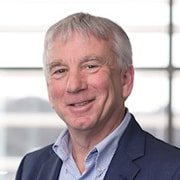We can never solve the climate challenge without addressing the world’s pressing water crisis. Sometimes, in some parts of the world, this manifests itself in the form of droughts, which leads to a lack of drinking water, poor sanitation, and in some cases unsafe environmental conditions that can lead to a tremendous fire risk. But too much water is also a major challenge. Flooding from climate change induced extreme weather has become all too common. And this not only causes property damage and loss of life, it can also threaten clean drinking water supplies.
Given all of this, it’s fair to say that water is mankind’s most valuable resource. And it’s always been a focus for our company, whose roots are in helping the people of the Netherlands manage and live with water. Over our more than 130 years, we have carried that water expertise all around the world, improving quality of life for millions. In honor of World Water Day, I wanted to share some stories about a handful for modern day examples of this work and how we’re helping the world secure a more resilient and sustainable relationship with water.

Florida’s Miami-Dade County, USA
Surrounded by water, Miami-Dade County, Florida features attractive stretches of coastline and tropical wetlands, vibrant communities, and a strong economy driven by tourism and agriculture. But climate change and a rising sea level are forcing the people of Miami-Dade County to rethink their relationship with water. The increasing frequency and impact of flooding is jeopardizing homes and property values because of the impact on critical facilities and infrastructure such as drainage and wastewater systems. This is also a threat to the drinking water supply for residents, putting health, safety, and livelihoods at risk. Water, which, in many ways has made the region an attractive place to live, is now threatening to make parts of the county uninhabitable.
In consultation with stakeholders and working together with Arcadis experts and our partners, Miami-Dade is stepping up to the challenge. Together with stakeholders and communities within the county, the Arcadis team developed Miami-Dade’s “Sea Level Rise Strategy”. The strategy presents a unique set of adaptation approaches, key actions, tools, and case studies to guide adaptation to sea level rise. Together with Miami-Dade and our partners, we developed six guiding principles to ensure a safe, equitable, and clean community that can change with conditions, work with instead of against nature, and streamline actions with other initiatives. The “Sea Level Rise Strategy” contains the roadmap for Miami-Dade County on how best to address the effects of climate change over the next 10 years and how to start on a path to climate resiliency. The plan represents an important opportunity to rejuvenate residents’ relationship with water.
Hampshire, United Kingdom
The more than 1.5 million people living in the Hampshire region of England are dealing with more frequent extreme weather events and population growth, both of which are stretching their finite natural resources, including water. With relatively little ground water reserves, this part of the country is water-stressed and new regulations have been put in place to limit the amount of water that can be taken and used from the two main rivers: the Test and the Itchen.
Our client Southern Water is radically reshaping its operations in order to continue providing safe and reliable water, as well as wastewater treatment for the people living in Hampshire and beyond. This 1 billion pound (GBP) effort includes a range of projects aimed at increasing the region’s water resilience. This includes mega-projects to develop new water sources, building up to 125 kilometers of new water mains to transport water around the region and collaboration with neighboring water companies to build new reservoirs and secure alternative supplies. It also involves addressing leakages to stop precious water from being wasted and efforts to reduce customer demand and improve catchment management. Arcadis experts are supporting Southern Water across the delivery of this complicated effort with program, project and commercial management services, asset management advice, and optimization of engineering solutions. In doing so, we helping to enhance water resilience for people living in this region, ensuring seamless access to clean water while safeguarding the natural environment.
The Afsluit Dike, the Netherlands
With an extended coastline at the North Sea, the delta of three important European rivers, and nearly one third of the country below sea level, the Netherlands has a complex history with water. For centuries, the Dutch worked against water to secure land for people to live safely and establish communities. But with a changing climate and rising sea levels, the country’s flood defenses need near constant enhancements and innovation. The Afsluit Dike, first completed in 1932, stands as a marvel of Dutch engineering that protects the land and inhabitants from the sea. The Afsluit Dike is a vast closure dike built to separate Lake IJssel (IJsselmeer in Dutch) from the Wadden Sea. It primarily protects again floodwaters from the Wadden Sea and allows controlled drainage from the Ijsselmeer but is more than just a water barrier. It also connects the provinces of North Holland and Friesland and includes multiple sluice gates, enabling access and mobility between each province and body of water. But the Afsluit Dike needs to be enhanced to ensure it will continue to protect people living in the Netherlands well into the future.
In response, the Dutch Ministry of Public Works asked the LEVVEL consortium, to design, build, help secure financing, and maintain a viable solution for the dam’s renovation. Arcadis is part of the design team of LEVVEL. The design integrates various approaches to achieve protection against a massive storm surge, that would likely only occur once every 10,000 years. The design will provide this extraordinary level of protection with an eye towards sustainability. Although the dike must be heightened and pumping capacity expanded, this will be done in part by using sustainable materials and with the use of renewable energy generated on or around the dike. The design also features a constructed river that draws on “building with nature” concepts to reestablish the natural of water flow between the Wadden Sea and Lake IJssel, facilitating fish migration and water exchange between the two bodies of water. This will help create a healthier coastal and lake ecosystem. In the Netherlands, water creates continuous challenges for people, as well as opportunities to use innovation to contribute to climate resilience. Instead of working against water, Arcadis and the people living in the Netherlands are learning new ways to work and live with water for the benefit of both people and nature.
Manila, the Philippines
Metro Manila exemplifies the water challenges that arise at the intersection between urbanization and climate change. Metro Manila’s more than 12 million people live in not only one of the most densely populated urban areas, but also in a country that is highly vulnerable to the impacts of climate change. Many people live in informal settlements that often experience extreme weather and flooding events, phenomenon that are only increasing in intensity and frequency. Approximately 97% of residents’ fresh water supply also comes from only one source, the Angat Dam, increasing the population’s vulnerability to water related challenges.
To increase water resilience for the people of Metro Manila, our teams at Arcadis are involved in numerous projects throughout the region. One project involves the engineering, procurement, and construction management of infrastructure downstream from the Kaliwa Dam, to provide an additional water source for the region. Arcadis is also conducting a feasibility study and conceptual design of a water treatment facility to draw and treat the polluted water from Laguna Lake. Additionally, our teams conducted assessments and rehabilitation efforts along the 21 kilometers of tunnels that convey water from the Angat Dam to six aqueducts. This work will improve operational flexibility and allow for the refurbishment of older tunnels without putting the region’s water supply at risk. Through these and many other projects throughout the region, Arcadis is helping to secure a more safe and reliable water supply for Metro Manila’s growing population.
São Paulo, Brazil
Supplying water to Greater São Paulo, where more than 21 million people live, is a significant challenge that is complicated further by climate change. Between 2015 and 2017, the region experienced a period of extreme drought, which lowered dam levels, and thereby fresh water supply, to critical levels. People in São Paulo were faced with an all too close reality – what would happen if they did not have access to fresh water? Although this outcome was ultimately avoided, several actions emerged to ensure that São Paulo’s fresh water supply would be more secure in the future.
Arcadis supported our client Sabesp in two connected projects, the Loss Reduction Programs in supply systems and the construction of the São Lourenço Water Treatment Plant, to safeguard an uninterrupted and safe water supply. Over six years, Arcadis helped to develop the Loss Reduction Program. This program involved replacing and constructing water pipelines and household water connections to reduce water loss from leakage and expand the drinking water supply network. The program achieved a more than 30% reduction in water loss from household pipes, and now delivers a reliable fresh water supply to more than 4 million São Paulo inhabitants. Arcadis also supported Sabesp, for more five years, with the design, program management, and construction of the São Lourenço Water Treatment Plant. This treatment plant provides a level of pollution control, and ensures that water supplied to residents is safe. By improving water use efficiency and connecting more people to a clean source of water, Arcadis has helped increase São Paulo’s water security and helped the region establish a more water resilient system.





